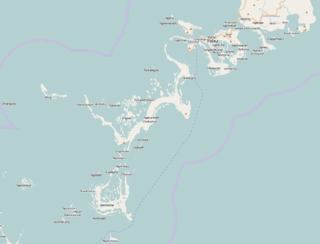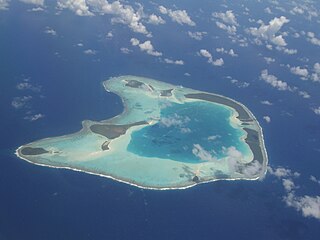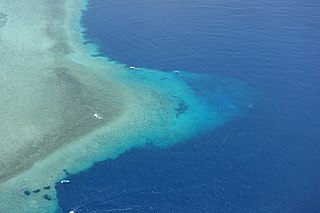 | |
| Chair | Noah Idechong |
|---|---|
| CEO | Yimnang Golbuu |
| Location | |
| Coordinates | 7°20′19.4″N134°27′59.6″E / 7.338722°N 134.466556°E |
| Website | Official website |
The Palau International Coral Reef Center (PICRC) is a coral reef research center in Koror, Palau.
 | |
| Chair | Noah Idechong |
|---|---|
| CEO | Yimnang Golbuu |
| Location | |
| Coordinates | 7°20′19.4″N134°27′59.6″E / 7.338722°N 134.466556°E |
| Website | Official website |
The Palau International Coral Reef Center (PICRC) is a coral reef research center in Koror, Palau.
The research center is currently headed by Yimnang Golbuu. [1]
The center building features an aquarium, conference room, library, meeting rooms, gift shop etc. [2]

The Republic of Palau consists of eight principal islands and more than 250 smaller ones lying roughly 500 miles southeast of the Philippines, in Oceania. The islands of Palau constitute the westernmost part of the Caroline Islands chain. The country includes the World War II battleground of Peleliu and world-famous rock islands. The total land area is 459 km2 (177 sq mi). It has the 42nd largest Exclusive Economic Zone of 603,978 km2 (233,197 sq mi).

An atoll is a ring-shaped island, including a coral rim that encircles a lagoon. There may be coral islands or cays on the rim. Atolls are located in warm tropical or subtropical parts of the oceans and seas where corals can develop. Most of the approximately 440 atolls in the world are in the Pacific Ocean.

Koror is the state comprising the main commercial centre of the Republic of Palau. It consists of several islands, the most prominent being Koror Island. It is Palau’s most populous state.

A coral reef is an underwater ecosystem characterized by reef-building corals. Reefs are formed of colonies of coral polyps held together by calcium carbonate. Most coral reefs are built from stony corals, whose polyps cluster in groups.

The Philippine Sea is a marginal sea of the Western Pacific Ocean east of the Philippine Archipelago and the largest sea in the world, occupying an estimated surface area of 5 million square kilometers. The Philippine Sea Plate forms the floor of the sea. Its western border is the first island chain to the west, comprising the Ryukyu Islands in the northwest and Taiwan in the west. Its southwestern border comprises the Philippine islands of Luzon, Catanduanes, Samar, Leyte, and Mindanao. Its northern border comprises the Japanese islands of Honshu, Shikoku and Kyūshū. Its eastern border is the second island chain to the east, comprising the Bonin Islands and Iwo Jima in the northeast, the Mariana Islands in the due east, and Halmahera, Palau, Yap and Ulithi in the southeast. Its southern border is Indonesia's Morotai Island.

Oxybenzone or benzophenone-3 or BP-3 is an organic compound belonging to the class of aromatic ketones known as benzophenones. It is a pale-yellow solid that is readily soluble in most organic solvents. It is widely used in sunscreen formulations, plastics, toys, furniture finishes, and other products to limit UV degradation. In nature, oxybenzone can be found in various flowering plants. The compound was first synthesised in Germany by chemists König and Kostanecki in 1906.

Coral bleaching is the process when corals become white due to various stressors, such as changes in temperature, light, or nutrients. Bleaching occurs when coral polyps expel the zooxanthellae that live inside their tissue, causing the coral to turn white. The zooxanthellae are photosynthetic, and as the water temperature rises, they begin to produce reactive oxygen species. This is toxic to the coral, so the coral expels the zooxanthellae. Since the zooxanthellae produce the majority of coral colouration, the coral tissue becomes transparent, revealing the coral skeleton made of calcium carbonate. Most bleached corals appear bright white, but some are blue, yellow, or pink due to pigment proteins in the coral.

The Rock Islands of Palau, also called Chelbacheb, are a collection of several hundred small limestone or coral uprises in the Southern Lagoon of Palau between Koror and Peleliu, now an incorporated part of Koror State. There are between 250 and 300 islands in the group according to different sources, with an aggregate area of 42 square kilometers (16 sq mi) and a maximum height of 207 meters (679 ft). The islands were declared a UNESCO World Heritage Site in 2012.

The giant clams are the members of the clam genus Tridacna that are the largest living bivalve mollusks. There are several species of "giant clams" in the genus Tridacna, which are often misidentified for Tridacna gigas, the most commonly intended species referred to as "the giant clam".

Kayangel (Ngcheangel) is the northernmost state of Palau 24 km (15 mi) north of Koror. The land area is about 1.4 km2 (0.54 sq mi). The population is 54. There is one hamlet in the state - Orukei which is also its capital.

A coral island is a type of island formed from coral detritus and associated organic material. It occurs in tropical and sub-tropical areas, typically as part of a coral reef which has grown to cover a far larger area under the sea. The term low island can be used to distinguish such islands from high islands, which are formed through volcanic action. Low islands are formed as a result of sedimentation upon a coral reef or of the uplifting of such islands.

The Coral Triangle (CT) is a roughly triangular area in the tropical waters around the Philippines, Indonesia, Malaysia, Papua New Guinea, the Solomon Islands and Timor-Leste. This area contains at least 500 species of reef-building corals in each ecoregion. The Coral Triangle is located between the Pacific and Indian oceans and encompasses portions of two biogeographic regions: the Indonesian-Philippines Region, and the Far Southwestern Pacific Region. As one of eight major coral reef zones in the world, the Coral Triangle is recognized as a global centre of marine biodiversity and a global priority for conservation. Its biological resources make it a global hotspot of marine biodiversity. Known as the "Amazon of the seas" (by analogy to the Amazon rainforest in South America), it covers 5.7 million square kilometres (2,200,000 sq mi) of ocean waters. It contains more than 76% of the world's shallow-water reef-building coral species, 37% of its reef fish species, 50% of its razor clam species, six out of seven of the world's sea turtle species, and the world's largest mangrove forest. In 2014, the Asian Development Bank (ADB) reported that the gross domestic product of the marine ecosystem in the Coral Triangle is roughly $1.2 trillion per year and provides food to over 120 million people. According to the Coral Triangle Knowledge Network, the region annually brings in about $3 billion in foreign exchange income from fisheries exports, and another $3 billion from coastal tourism revenues.

Coral reef protection is the process of modifying human activities to avoid damage to healthy coral reefs and to help damaged reefs recover. The key strategies used in reef protection include defining measurable goals and introducing active management and community involvement to reduce stressors that damage reef health. One management technique is to create Marine Protected Areas (MPAs) that directly limit human activities such as fishing.

Sonsorol is one of the sixteen states of Palau. The inhabitants speak Sonsorolese, a local Chuukic language, and Palauan.

Coral aquaculture, also known as coral farming or coral gardening, is the cultivation of corals for commercial purposes or coral reef restoration. Aquaculture is showing promise as a tool for restoring coral reefs, which are dying off around the world. The process protects young corals while they are most at risk of dying. Small corals are propagated in nurseries and then replanted on the reef.

Ulong is a major island and channel of western Palau. It is sometimes called Aulong and originally written Oroolong in English. Ulong is regarded by many as one of the best drift dives in the world.
Les Kaufman is an evolutionary ecologist specializing in the biology and conservation of aquatic ecosystems. He has special expertise in coral reef biology, the evolution and ecology of tropical great lakes fishes, and ecosystem-based management of marine resources.
Organizations which currently undertake coral reef and atoll restoration projects using simple methods of plant propagation:

Blue Corner is a section of Palau's barrier reef in the south-east of Koror, close to Ngerukewid and German Channel. Its triangular shape, with step walls on the Pacific Ocean sides, resembles a submerged peninsula. In the north part of the Blue Corner, there is a large underwater cavern called Blue Holes. Due to a high variety of corals and wildlife in the area, the Blue Corner is a popular recreational dive site. It is variously called "the most requested dive in Palau" and "one of the most action-packed scuba dive sites in the world."
Adrian Justin Jimena Ililau is a Palauan sprinter.